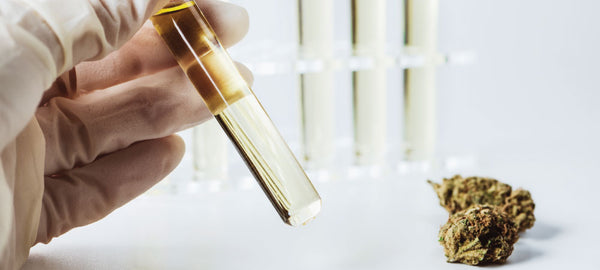Your Cart is Empty
ORGANIC CBD MADE WITH 💚 IN EUGENE, OR
ORGANIC CBD MADE WITH 💚 IN EUGENE, OR
ORGANIC CBD MADE WITH 💚 IN EUGENE, OR
September 16, 2022 4 min read
Have you ever wondered how much THC is in hemp versus marijuana?
It’s an exciting time to be in the CBD industry. As CBD continues to explode in popularity, many people who would have otherwise never tried cannabinoids are beginning to experience the benefits they offer.
And because so many people are brand new to cannabis therapy, there are inevitably lots of questions. Many of those questions have to do with the differences between CBD and THC, which we have addressed in another blog post.
But many people also wonder about how much THC is in hemp versus marijuana. That’s a great question! And like many things in the hemp industry, there’s both a simple answer and a more complicated one.
We’ll give you both here.

Because many people who ask this question just want the basics,the simple answer to this question is that hemp must contain less than 0.3% THC.
That is the amount that Congress decided on when it formally legalized hemp as a crop in the U.S. In the language of the 2018 Farm Bill, hemp is defined as “[t]he plant species Cannabis sativa L. and any part of that plant ... with a delta-9 tetrahydrocannabinol concentration of not more than 0.3 percent on a dry weight basis.”
Notice that the only legal difference between hemp and marijuana has nothing to do with the strain or variety of cannabis plant.
But traditionally, the word “hemp” has referred to types of cannabis (Sativa) that were more fibrous than leafy. This is because hemp was used for a huge range of products — from rope to paper to clothing.
Hemp was so vital to the U.S. economy that the governmentactively encouraged farmers to plant it — right up through the middle part of the twentieth century.
But suspicions grew as recreational use of the more cannabinoid-rich varieties of cannabis became more popular (what we now refer to as marijuana). And the rest is prohibition history.
Today, no matter what strain of cannabis you grow,if it has less than 0.3% THC, it is defined as hemp. But if that number rises even to 0.4% THC, you have marijuana, which is not federally legal.
When hemp oil is extracted from the plant (and by “hemp oil” we are referring to cannabinoid-rich hemp oil, not hemp seed oil, which is something else entirely) it must still contain only 0.3% THC.
At Kanibi, we make sure our numbers are well within those legal limits, so our customers never have to worry about breaking federal law.

So how did this 0.3% THC become the magical number that distinguishes between hemp and marijuana?
Well, blame Canada.
Dr. Ernest Small, a research botanist at Agriculture and Agri-Food Canada was thefirst scientist to suggest that number as the demarcation between the more fibrous Cannabis sativa and Cannabis indica (which has higher levels of cannabinoids).
In his words, that number was not arbitrary: “The 0.3% figure was based on my previous analyses of THC content in thousands of plants.”
However, he certainly didn’t foresee how that number would be used either…
“Over the years, I have had many inquiries regarding whether the 0.3% criterion was based on potential for abuse — i.e. the possibility of using hemp to get high.No, it was not — the criterion was based on the pattern of variation in the real world: it happens that for thousands of years people have selected plants for fiber (subsp. sativa; low-intoxicant plants) and for marijuana (subsp. indica; high-intoxicant plants), and my studies simply revealed this pattern.”
So the 0.3% number was never intended to be used as a legal definition of hemp, nor was it based on the potential “for abuse” (since you generally need much more than 0.3% THC to get high).
Nevertheless, the number took hold.

At Kanibi, we know our customers have different needs when it comes to their CBD oil(and the presence or absence of THC), so we’ve decided to offer a range of products that will address a wide range of issues.
Our signature product is ourFull Spectrum Kanibi Tincture, which is essentially cannabinoid-rich hemp oil combined with MCT oil. We guarantee that our products are labeled correctly, and we provide third-party lab tests on our website so that you can check results from an independent source.
This means that you never have to worry that our full-spectrum products contain less CBD than is labeled or more than 0.3% THC.We work with farmers and extractors who know what they’re doing, and then we test (and test again) to ensure that we’re delivering the goods.
We think there’s good reason to believe that THC has an important role to play when it comes to cannabinoid therapy, so we started our company offering full-spectrum options (ourCBD Softgels andCBD Sports Cream are both full spectrum).
But it’s important to note that, while the amount of THC in our full-spectrum products is not enough to make you high, if you need to be prepared to take a drug test for work, it could be problematic.
This is because THC builds up in our fatty tissue. So if you use a full-spectrum product consistently, those tiny amounts of the cannabinoid will be stored in your fat tissue and could cause you to fail a drug test.
We truly never want our customers to have to worry about that, so we also offer 0% THC products, which utilizes CBD isolate. This is just the CBD, with the other plant components and other cannabinoids stripped away.
Both ourIsolate CBD Oil and ourOrgani Gummies are isolate based, so entirely THC-free.
Whatever you choose, we want our customers to know that at Kanibi, we take THC content seriously — as an obligation to the law, but also to our customers’ well-being.
